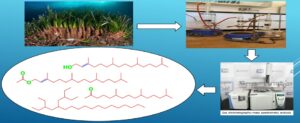Full paper
Fakhri Elabbar (1)*, Abdulsalam Alasply (1)
(1) Department of Chemistry, Faculty of Science, University of Benghazi, Benghazi, Libya
* Correspondence to: fakhri.elabbar@uob.edu.ly
Pages 1-8
Abstract
 Posidonia oceanica seagrass is endemic to the Mediterranean, and has very little information about volatile organic compounds. The plant was collected from Garyounis Beach in Benghazi, east of Libya, in September 2019. Plant parts, leaves, rhizomes, and roots were extracted using a Soxhlet extractor with Hexane. The compounds were characterized by gas chromatography–mass spectrometry. the extract’s chemical constituents were de-convoluted using AMDIS software (www.amdis.net), and the mass spectra of the compounds spectra were explained by fragmentation pattern and matched to authentic standard spectra from Wiley and the NSIT Library database. The results revealed sixteen compounds, dominated by nine long-chain hydrocarbons, three long-chain fatty acids, and a single long-chain ketone. This is the first discovery of 3-ethyl-5-(2ethyl-butyl-octadecane, 6,10,14-trimethylpentadecan-2-one, phytol, and phytyl acetate from this plant.
Posidonia oceanica seagrass is endemic to the Mediterranean, and has very little information about volatile organic compounds. The plant was collected from Garyounis Beach in Benghazi, east of Libya, in September 2019. Plant parts, leaves, rhizomes, and roots were extracted using a Soxhlet extractor with Hexane. The compounds were characterized by gas chromatography–mass spectrometry. the extract’s chemical constituents were de-convoluted using AMDIS software (www.amdis.net), and the mass spectra of the compounds spectra were explained by fragmentation pattern and matched to authentic standard spectra from Wiley and the NSIT Library database. The results revealed sixteen compounds, dominated by nine long-chain hydrocarbons, three long-chain fatty acids, and a single long-chain ketone. This is the first discovery of 3-ethyl-5-(2ethyl-butyl-octadecane, 6,10,14-trimethylpentadecan-2-one, phytol, and phytyl acetate from this plant.Keywords
Posidonia Oceanica, Seagrass, phytochemistry, GCMS, Libya
Posidonia Oceanica, Seagrass, phytochemistry, GCMS, Libya
First published: 29.02.2024